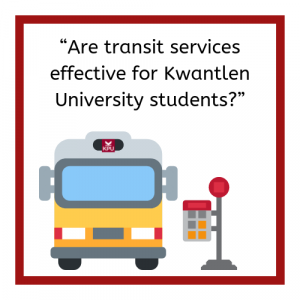7 Breaking Down an Assignment
Once you know about the expectations related to the type of writing that you are required to do, you can make a plan to gather information and develop your ideas.
Let’s look at an example, we’ll come back to this example throughout the different sections of this Pressbook…
An instructor in a first-year communication course asks students to complete the following assignment:
Write a 1,500 word persuasive essay that responds to the question: “Are transit services effective for Kwantlen University students?” Include your own perspective in your analysis and draw on two academic sources.

In my assignment, I’ll need to describe transit services. Once I have my description, I can include some analysis of those services, based on my own perspective and sources that I’ll need to identify. Because this is a persuasive essay, I want to make sure that I’m presenting a clear argument. I can already see that I’ll be using three types of academic writing in this one assignment!
As I work on my assignment, it is important that I keep checking back with the assignment instructions; I want to make sure that I’m staying on topic and responding to the question.
Now that I have an understanding of the type of assignment that I’m working on, I can begin to develop ideas, gather information, and organize what I want to say. We’ll look more closely at brainstorming and concept mapping, next.
Academic Sources:
- Are published in a peer-reviewed journal or by a reputable publisher
- Use academic or scholarly language
- Include a reference list
- Include the author’s credentials
- Report the results of some kind of research or study
From “General Education: Scholarly and Popular Resources” by Mount Royal University Library CC BY-NC-SA 4.0

